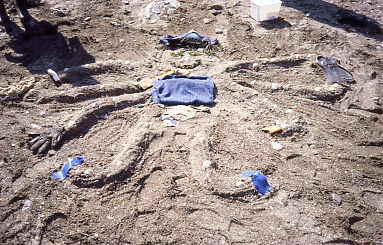|
 Normally done after shell
hunt, given
certain amount of time to create a beach sculpture / picture out of as many
different materials found on the beach. The art can only be of one thing from
the marine environment (whether mystical or not) Normally done after shell
hunt, given
certain amount of time to create a beach sculpture / picture out of as many
different materials found on the beach. The art can only be of one thing from
the marine environment (whether mystical or not)
Once the children have
been put into teams they are asked to create a beach sculpture or picture using
as many different materials as they can find on the beach. The art can only be
of one thing, either fact or fiction from the marine environment. The ranger
then judges all the work (fairly!) and a prize is awarded for the best one.
Points are allocated for the use of different materials found on the beach,
imagination and teamwork. This activity can be altered slightly so that a food
chain is created with each team making one of the levels.
-
Learn:
-
Team work
-
What can be found on the beach such as:
-
Worn glass- factors such as natural
recycling
-
Rubbish- Pollution and recycling
-
Seaweed- what types, why is it washed up,
what can be found on it etc
Shells
-
Different shades of sand- why
different?
Dry / wet / different sized particles.
A very creative activity
that encourages the children to work in teams and create their own beach art
using as many materials as they can find on the beach. The ranger then judges
all the artwork and a prize is awarded to the best one. This activity can be
altered slightly so that a food chain is created with each team making one of
the levels.
Aims of Activity
 To
encourage teamwork and creativity. To
encourage teamwork and creativity.
 To
discover all the different types of materials that are found on the beach. To
discover all the different types of materials that are found on the beach.
 To
think about whether the materials are natural or man made. To
think about whether the materials are natural or man made.
 To
think about rubbish, pollution and the importance of recycling. To
think about rubbish, pollution and the importance of recycling.
Relevant parts of the
National Curriculum.
SCIENCE
Primary
Secondary (using Food Chain)
-
Unit 7C: Environment
and feeding relationships.
-
Unit 8D: Ecological
relationships.
-
ART / DESIGN.
-
Investigate the possibilities of a range of materials.
-
To
answer questions about the starting points of their work and develop their
ideas.
-
To
review what they and others have done and say what they think and feel about
it.
-
Unit1B: Investigating
materials.
-
Unit2B: Mother nature,
designer.
-
Describe the visual qualities of their work.
-
Explain
how they created certain effects.
-
Collect
and group natural objects and make a visually attractive display.
|